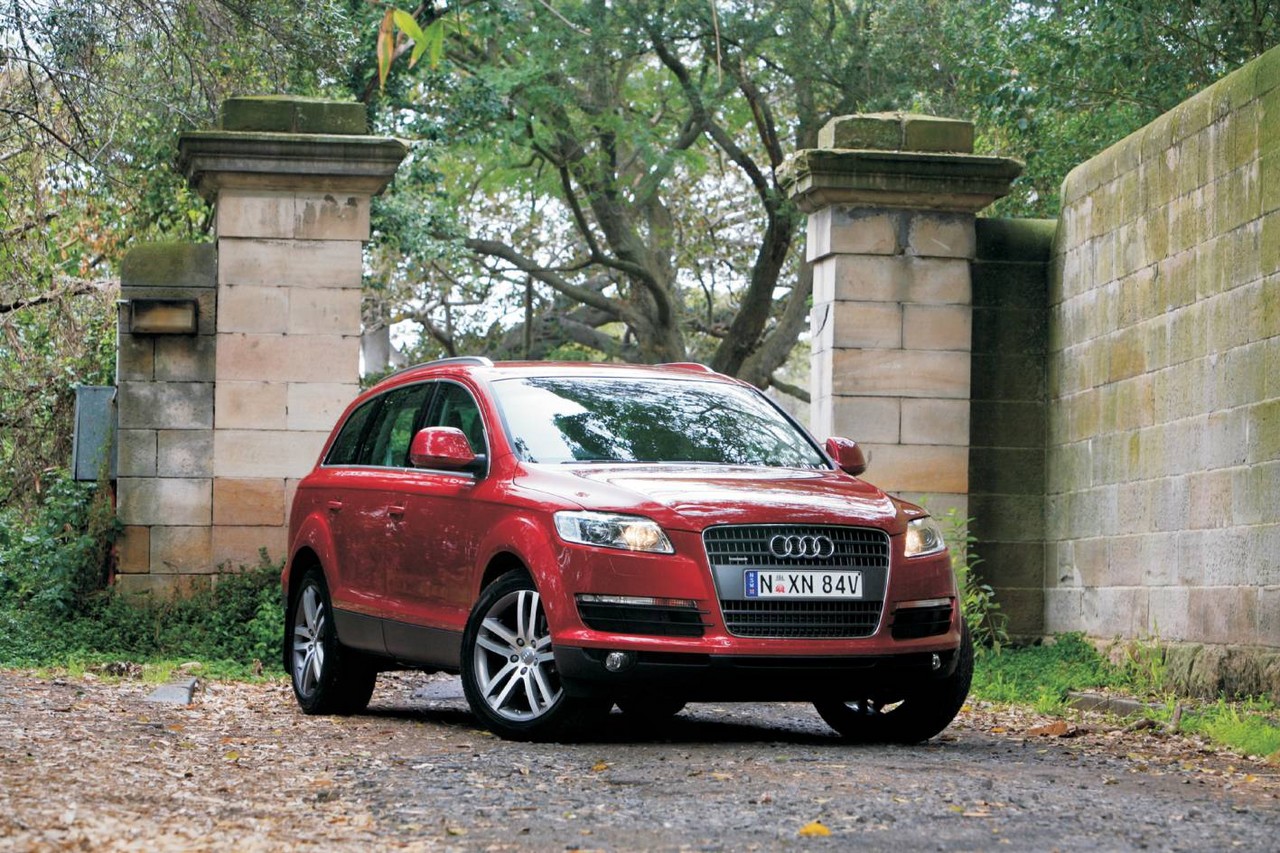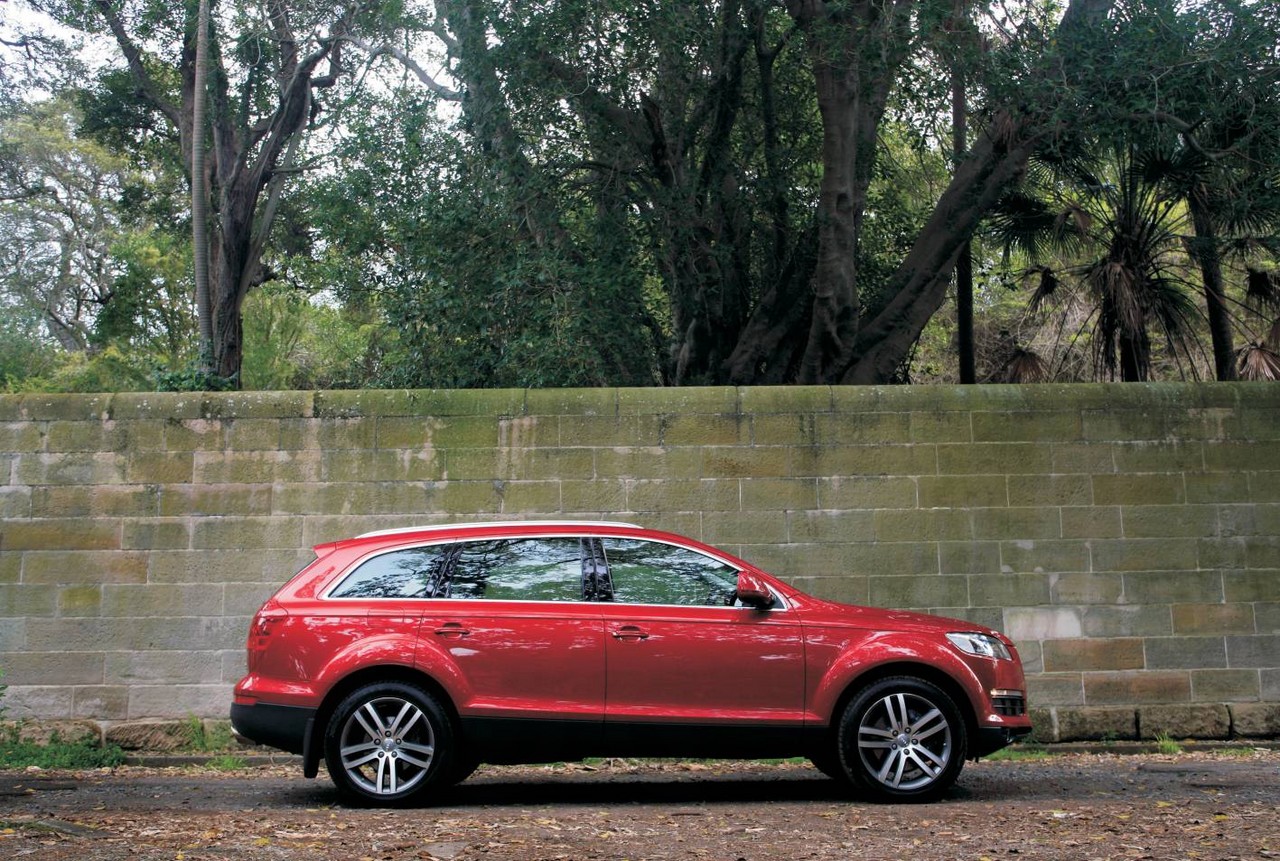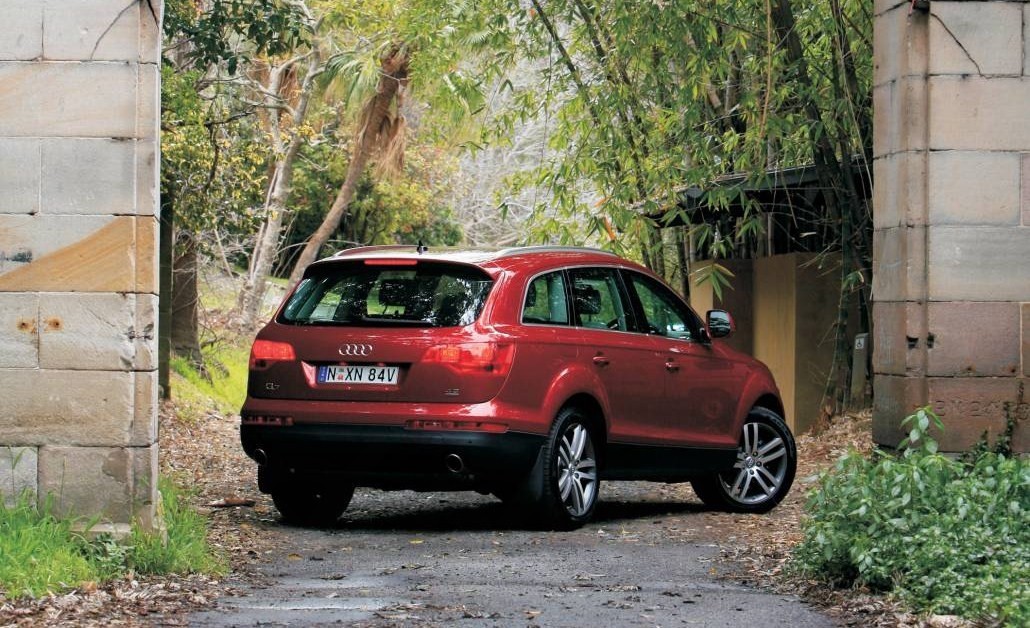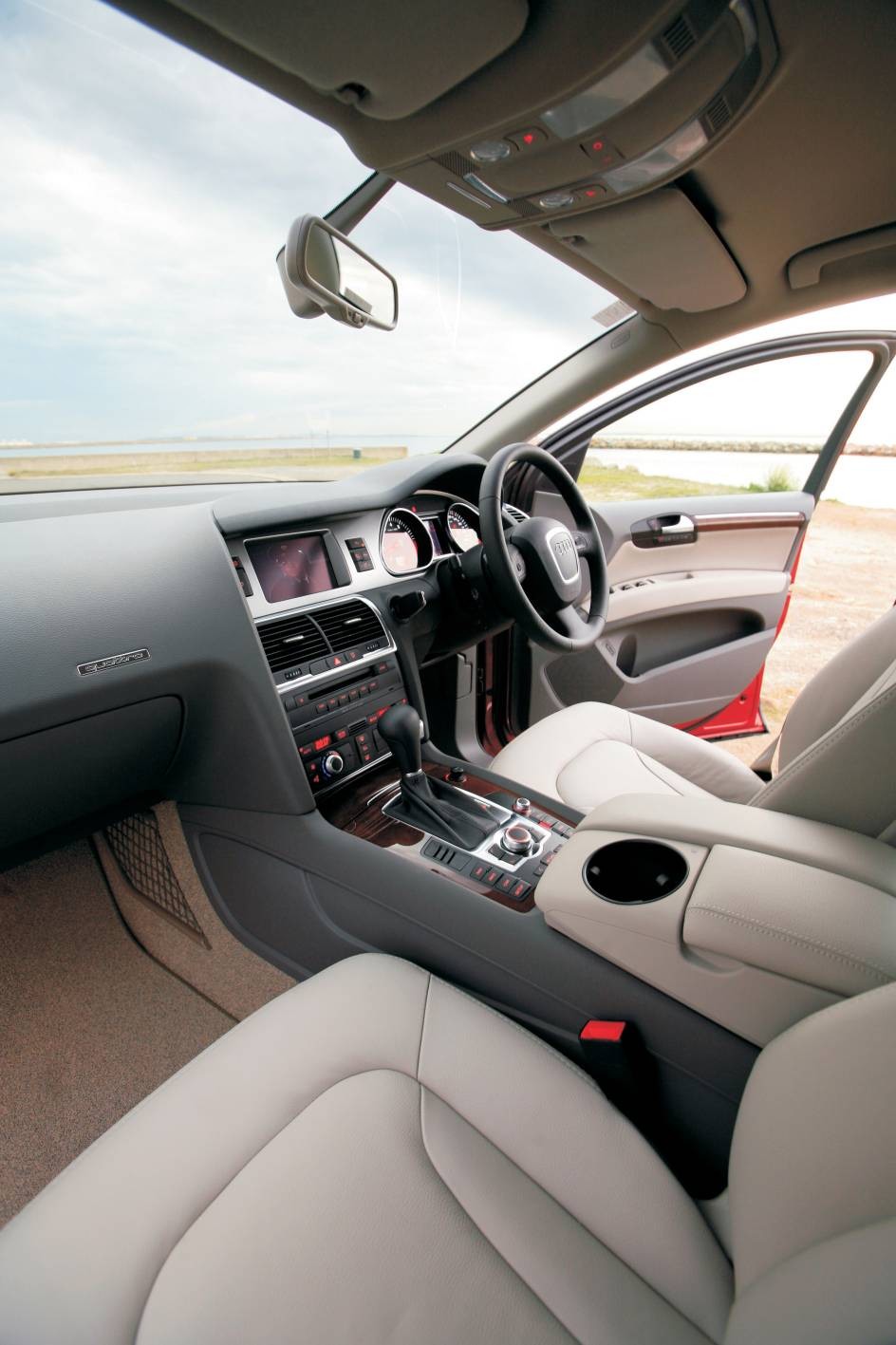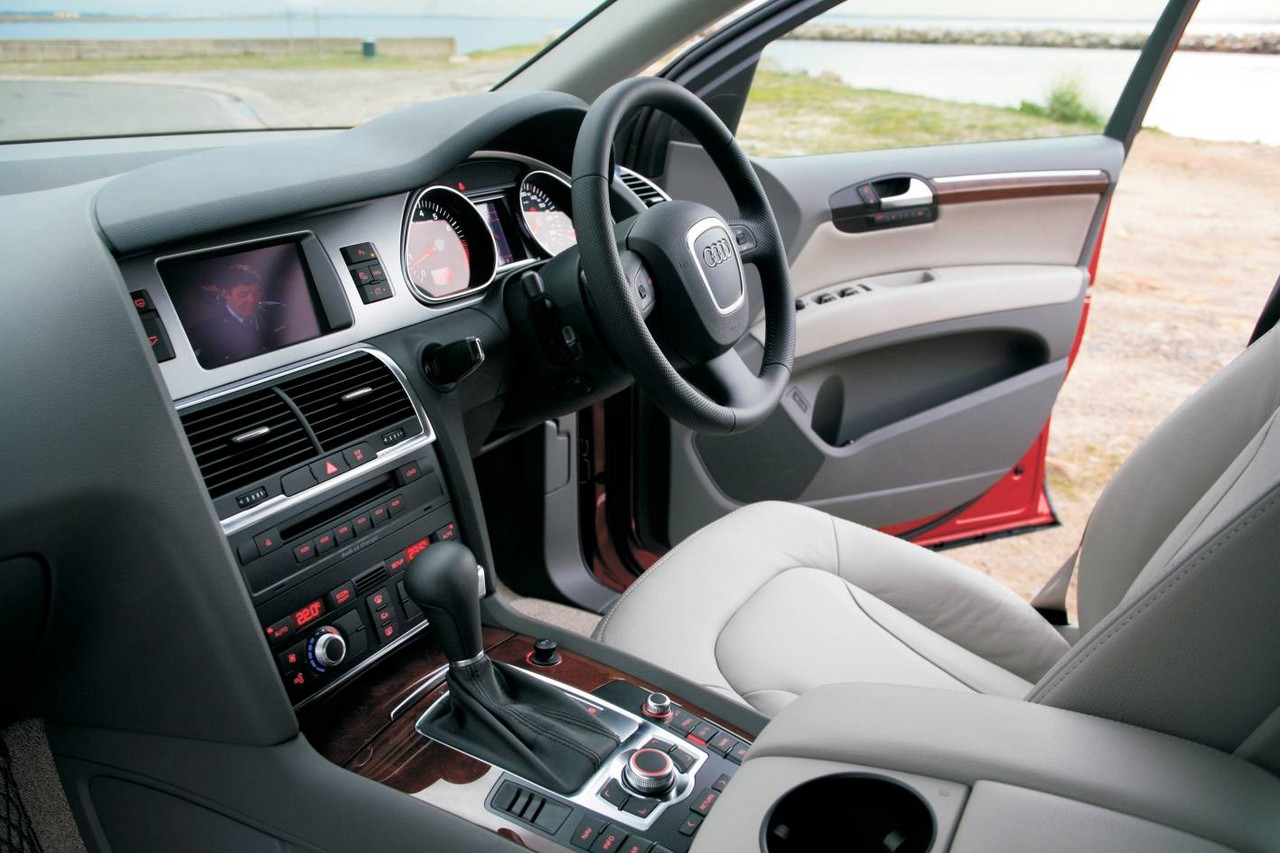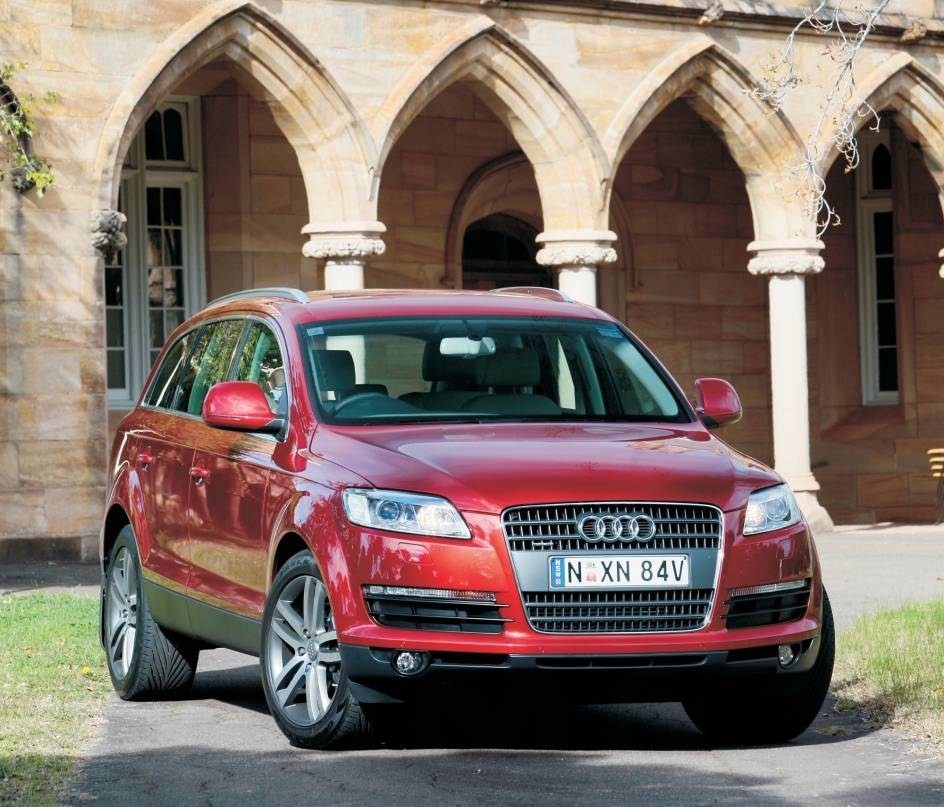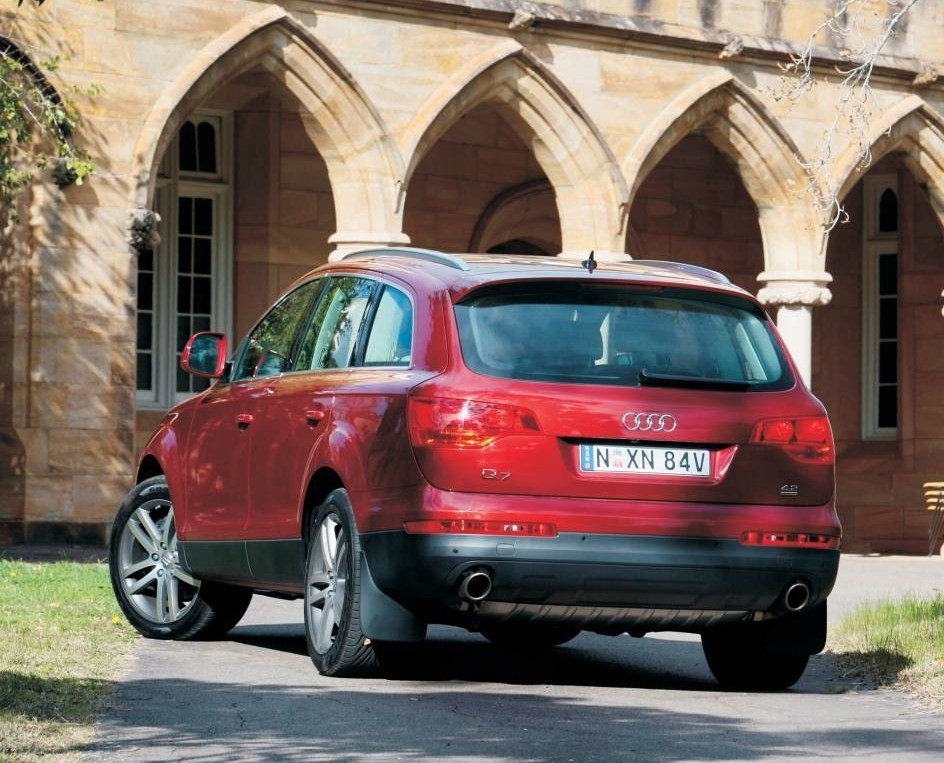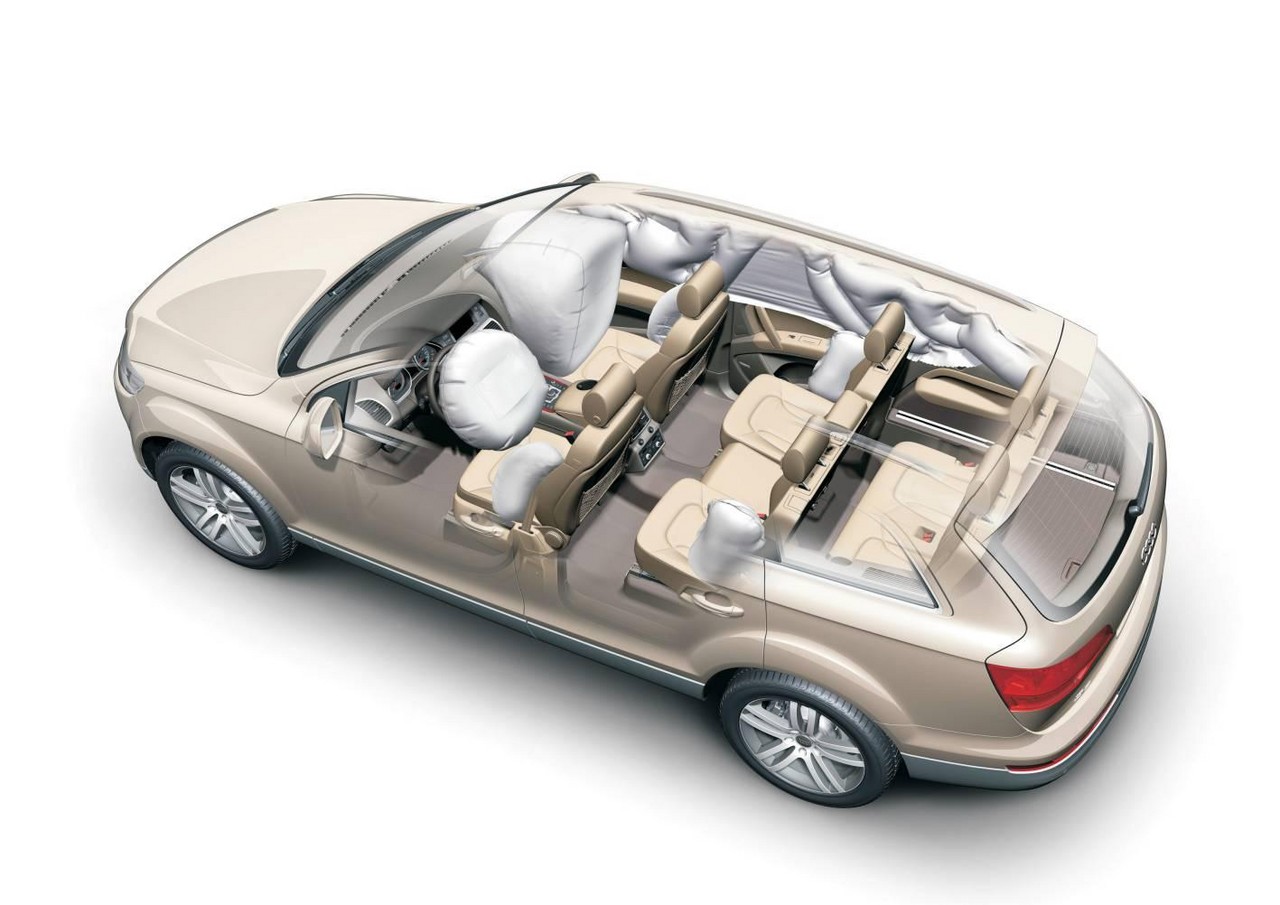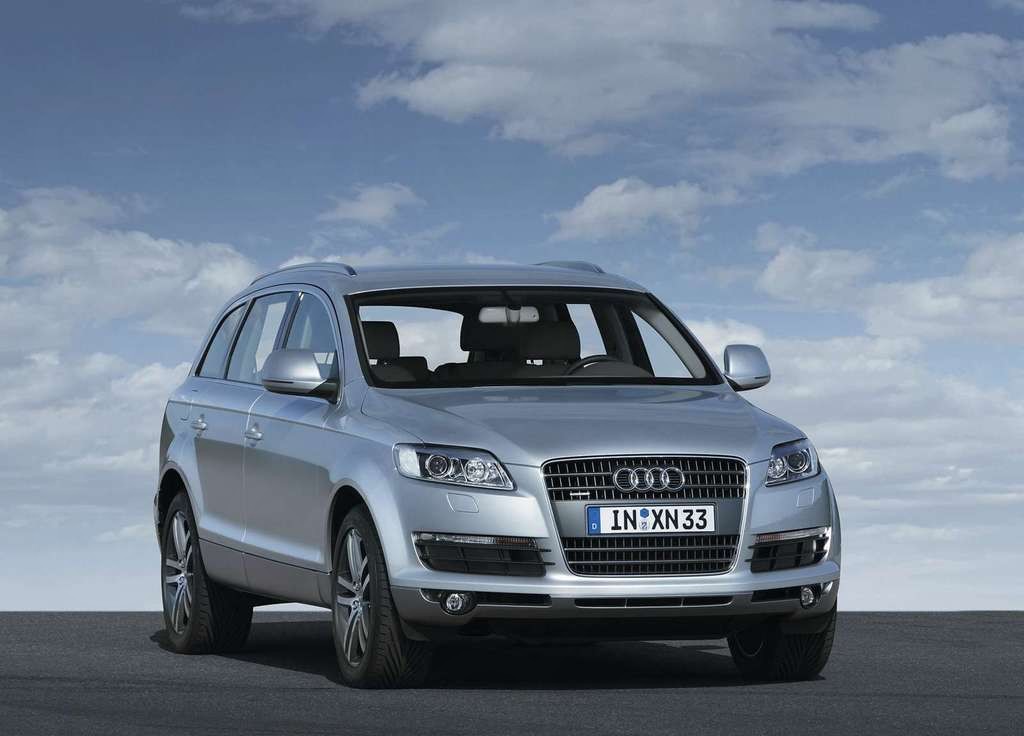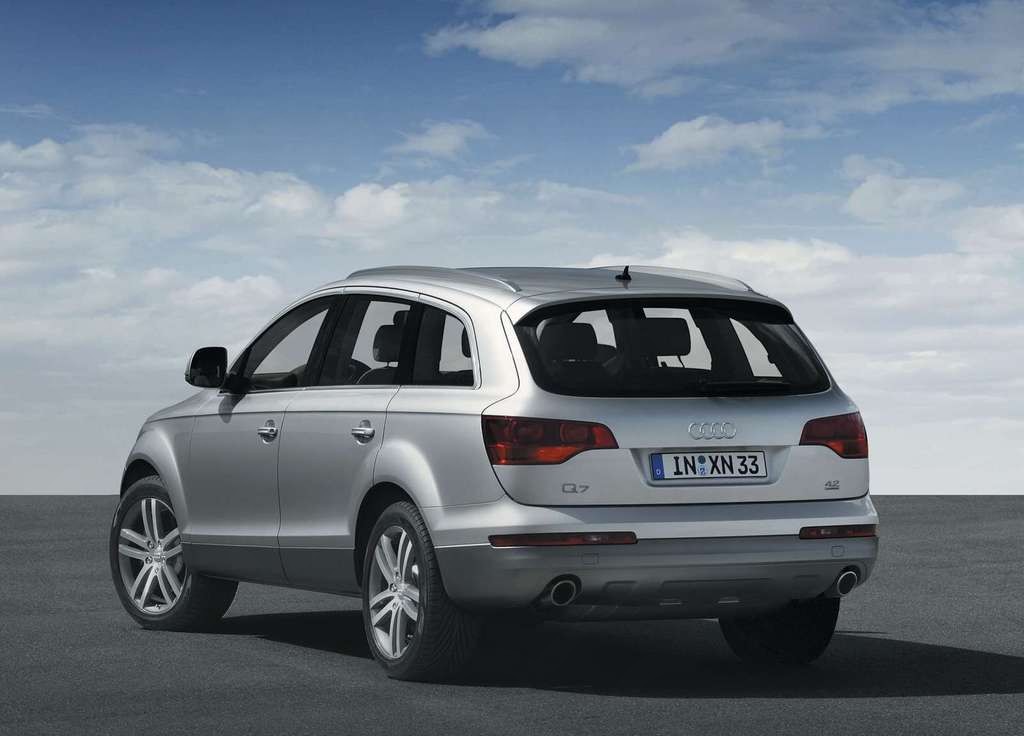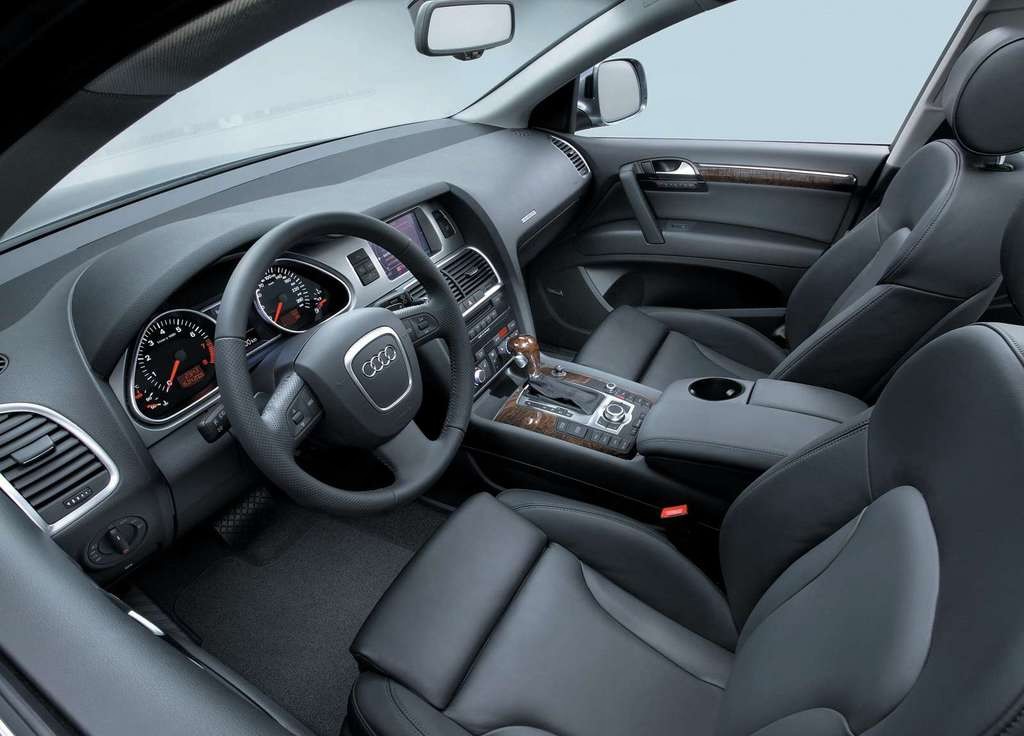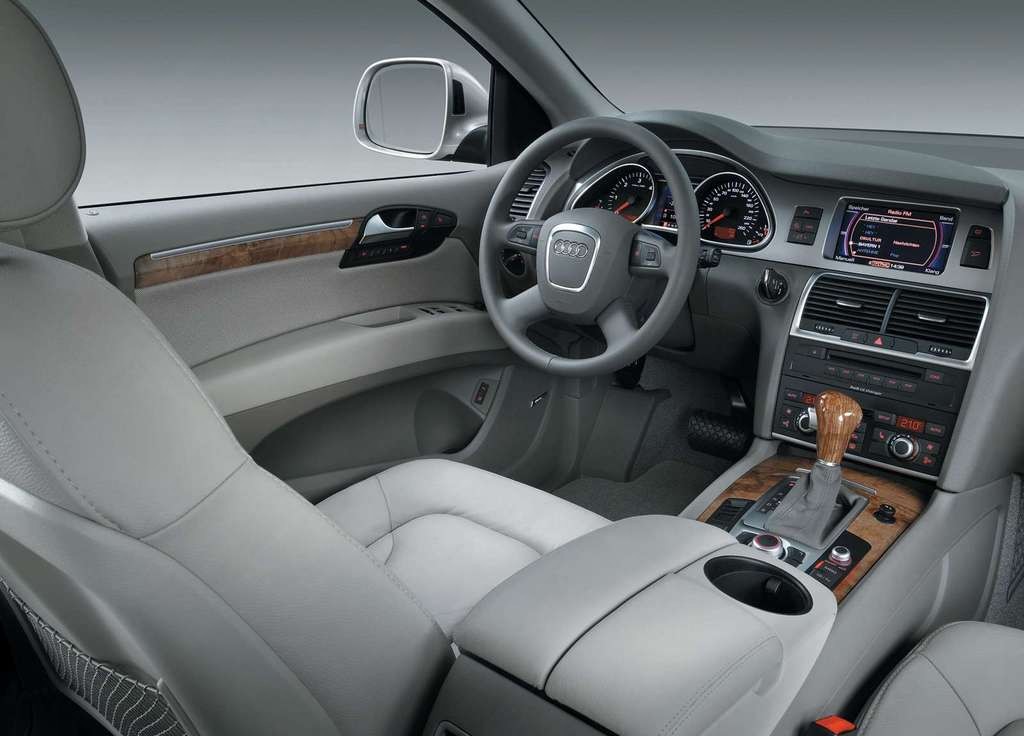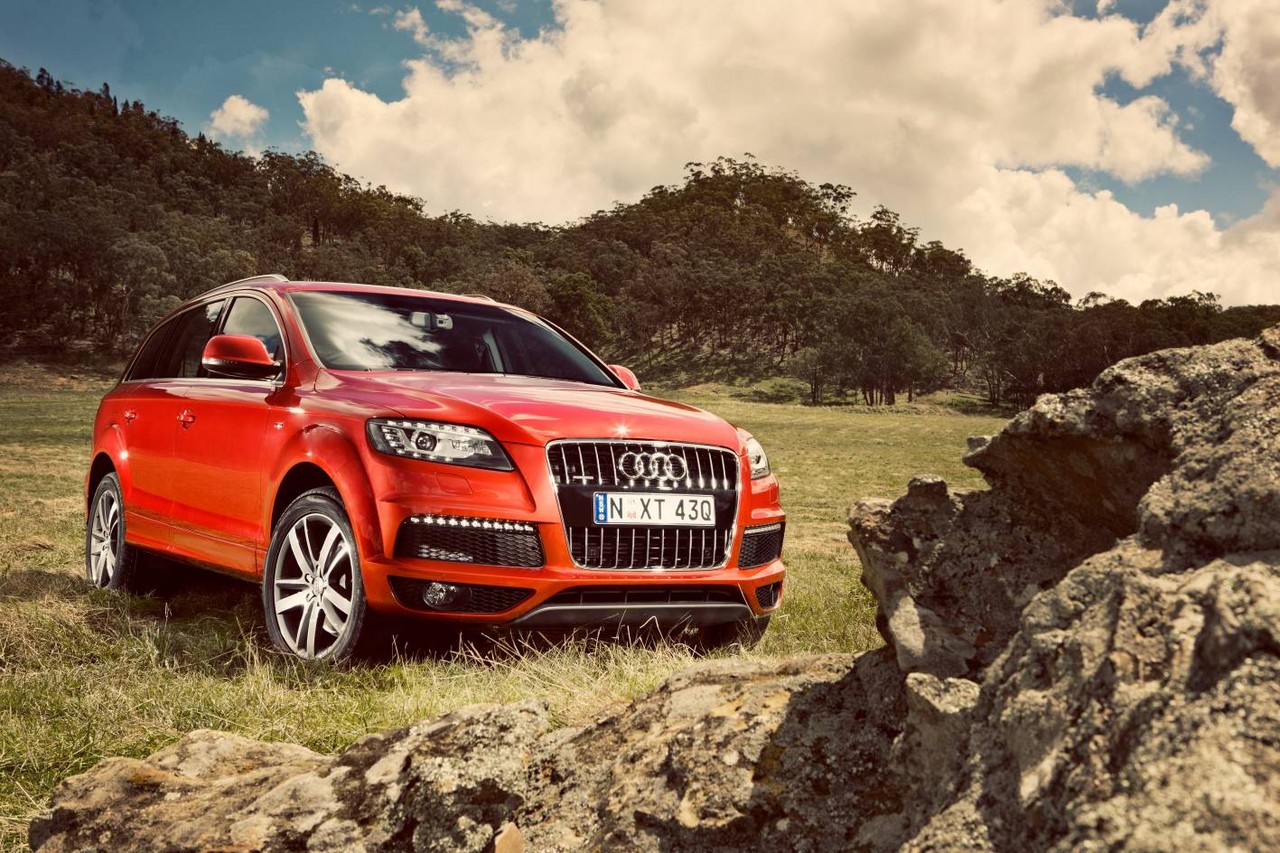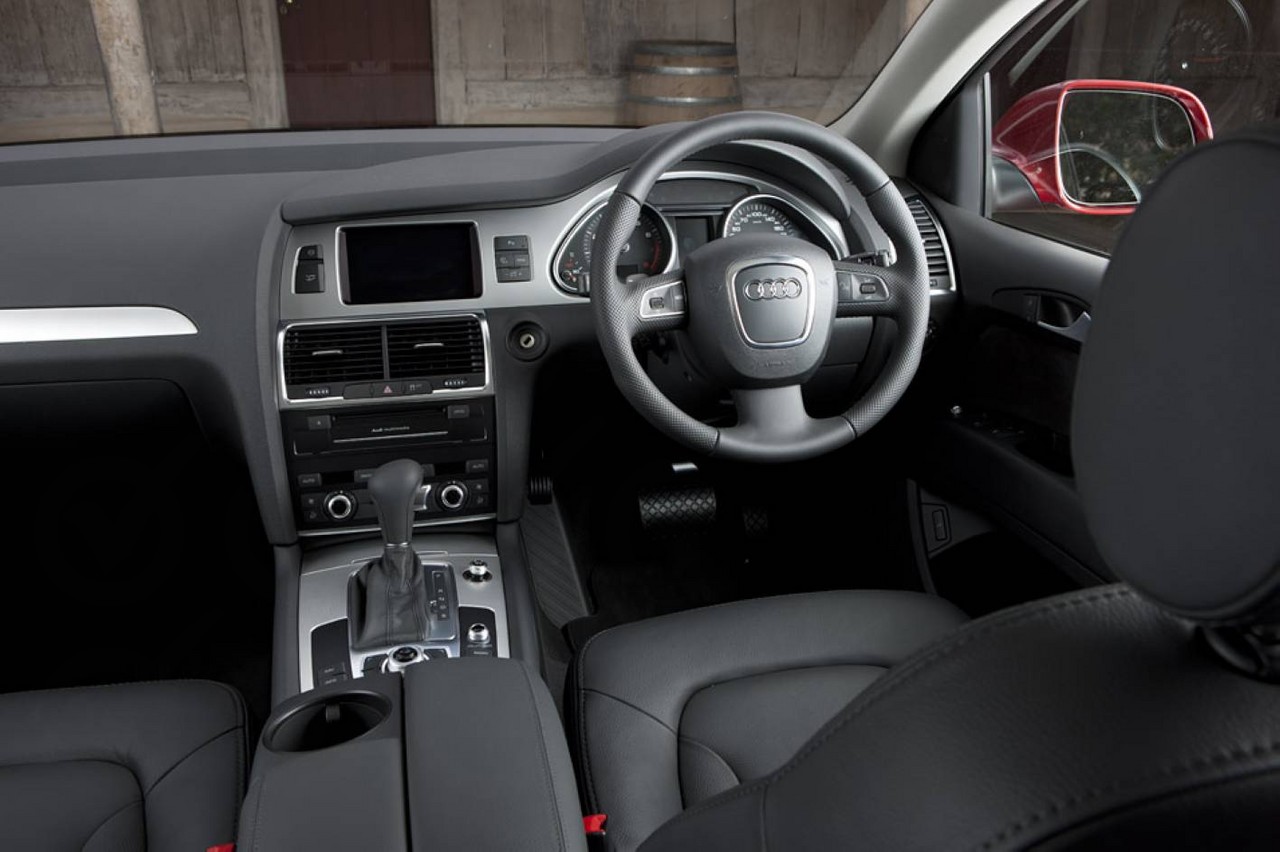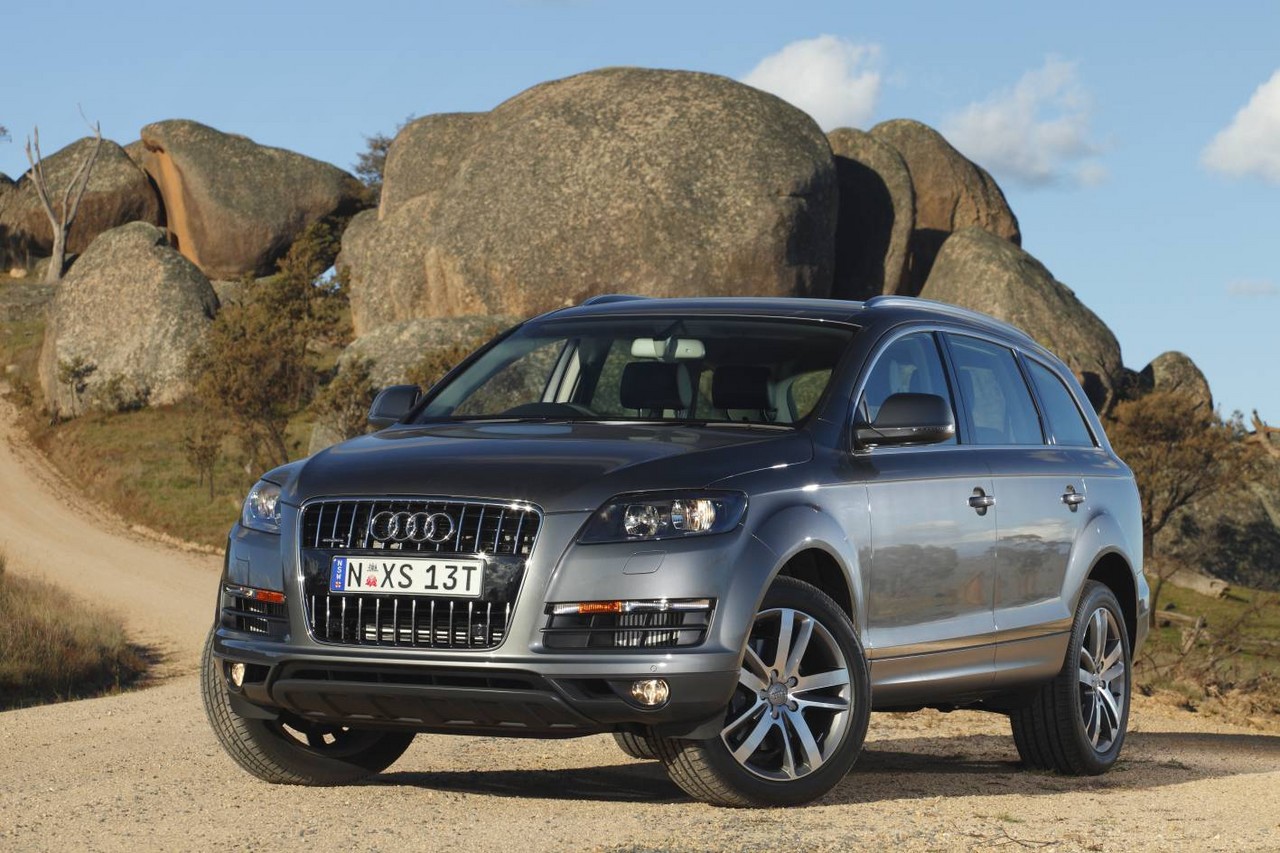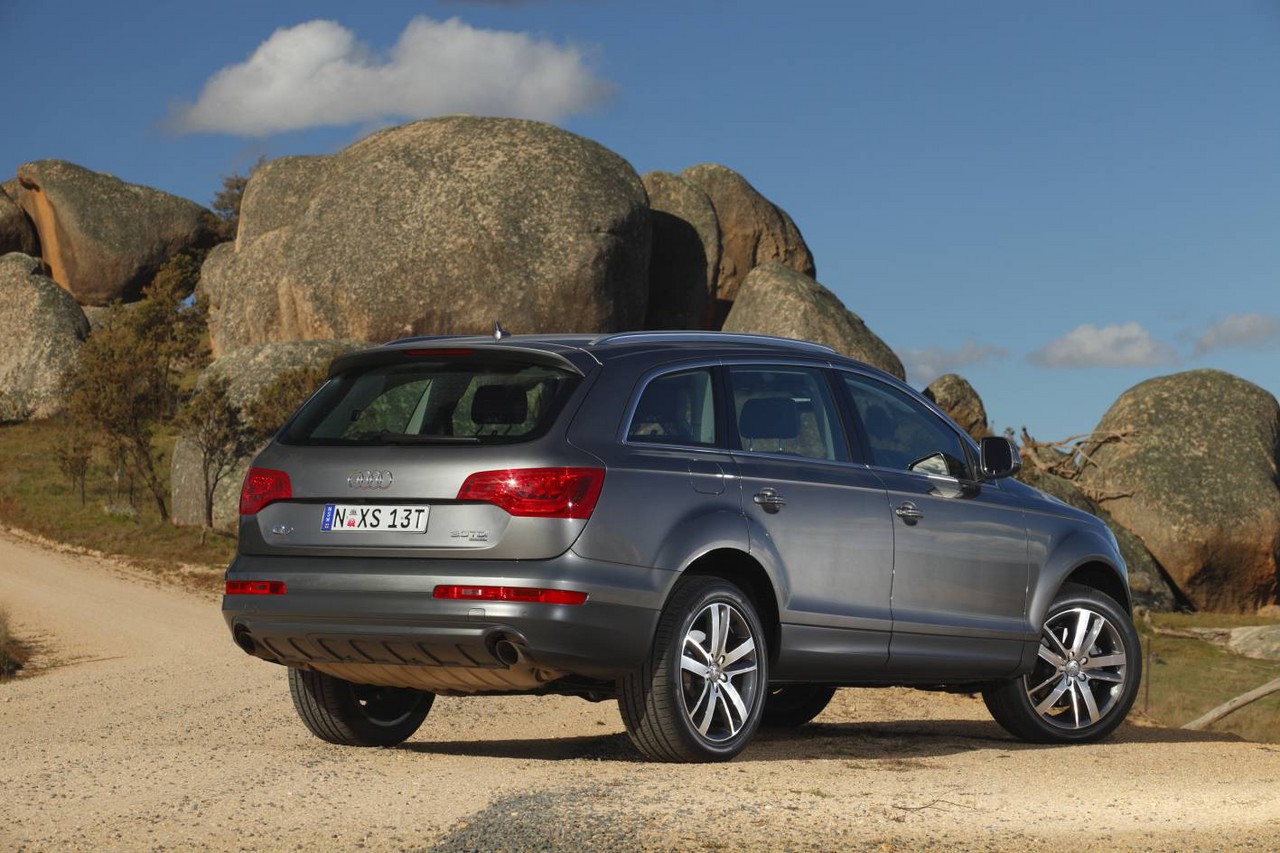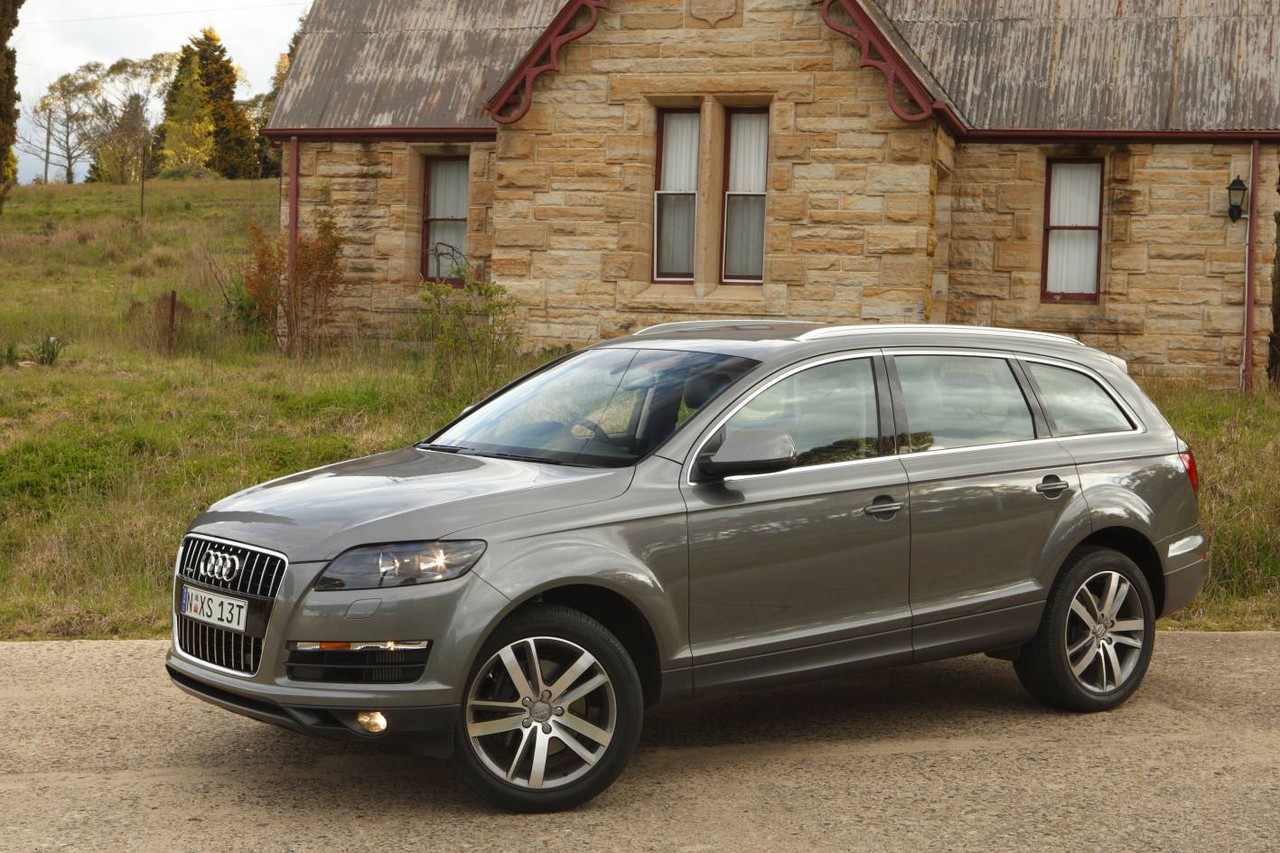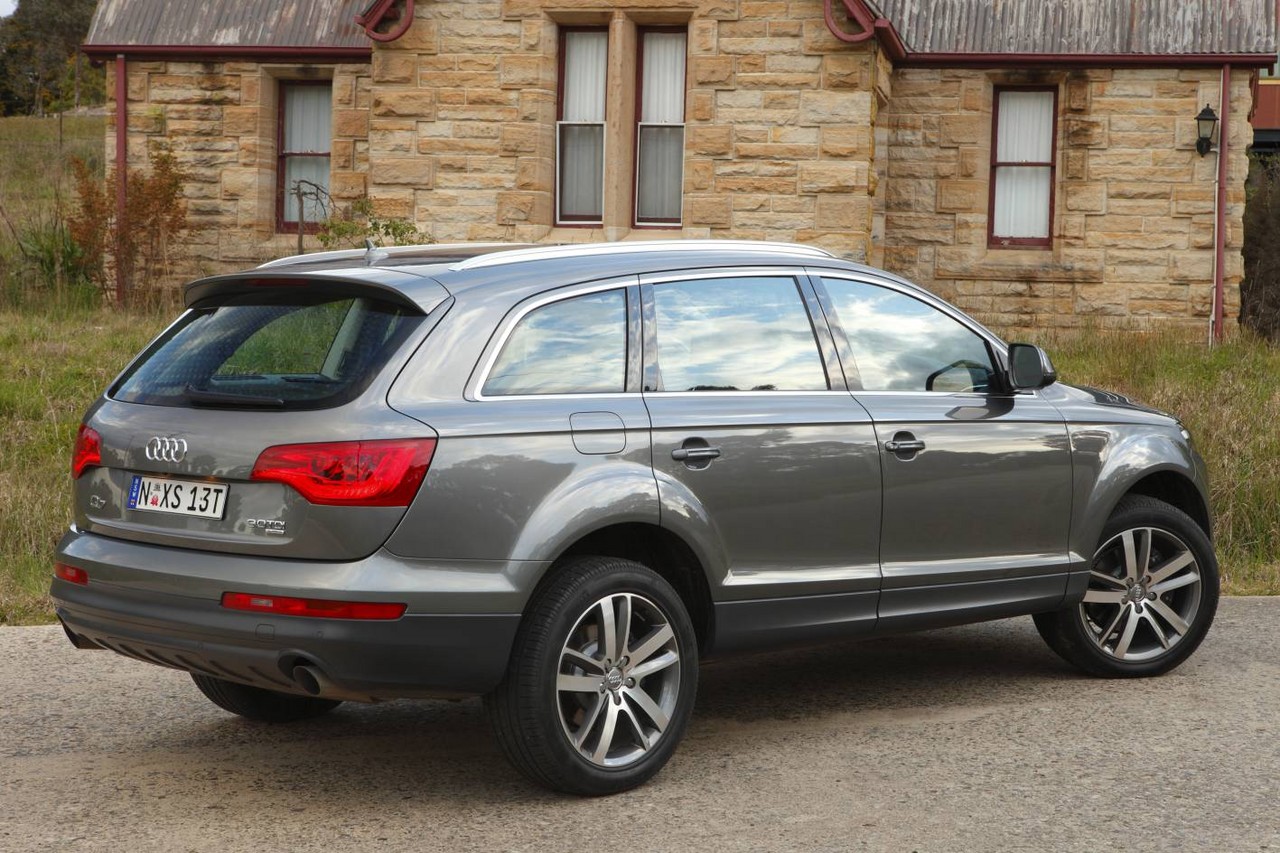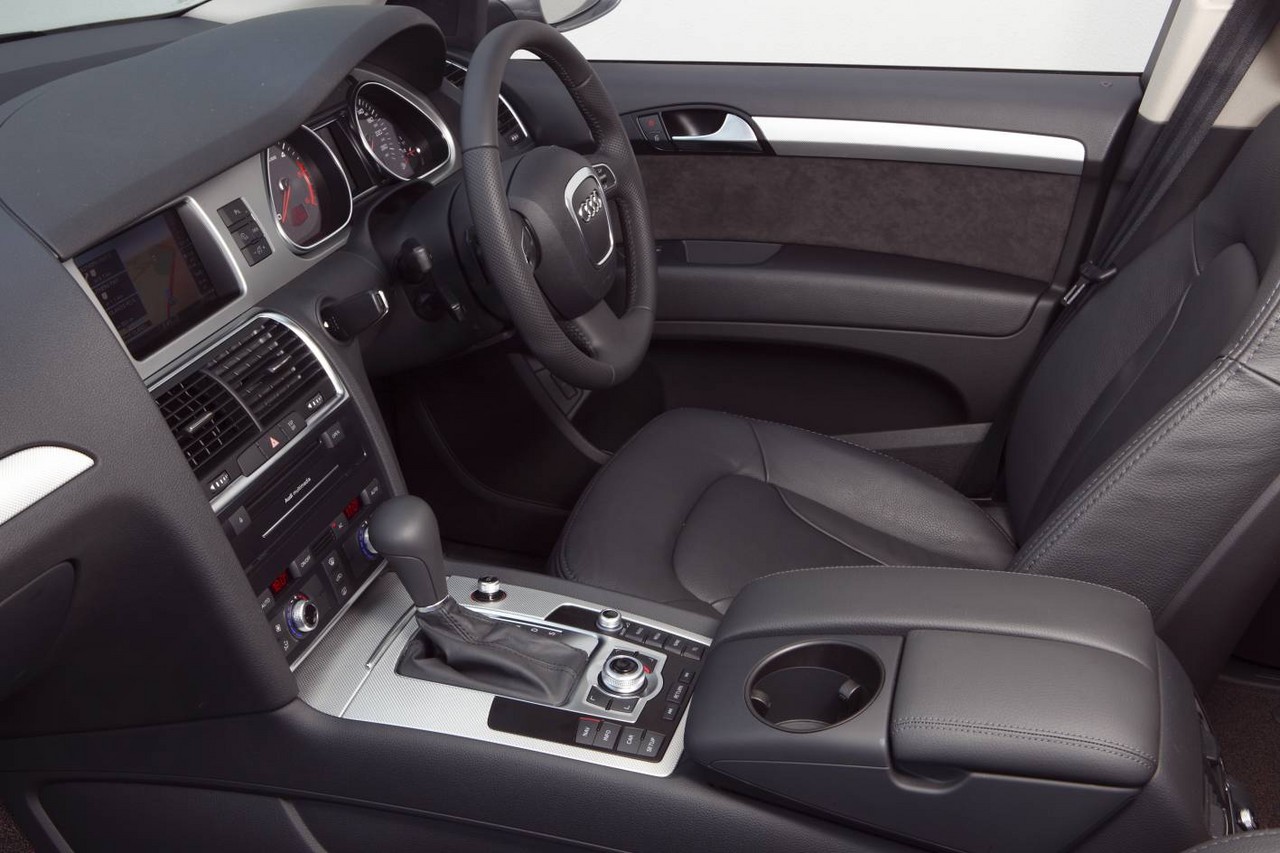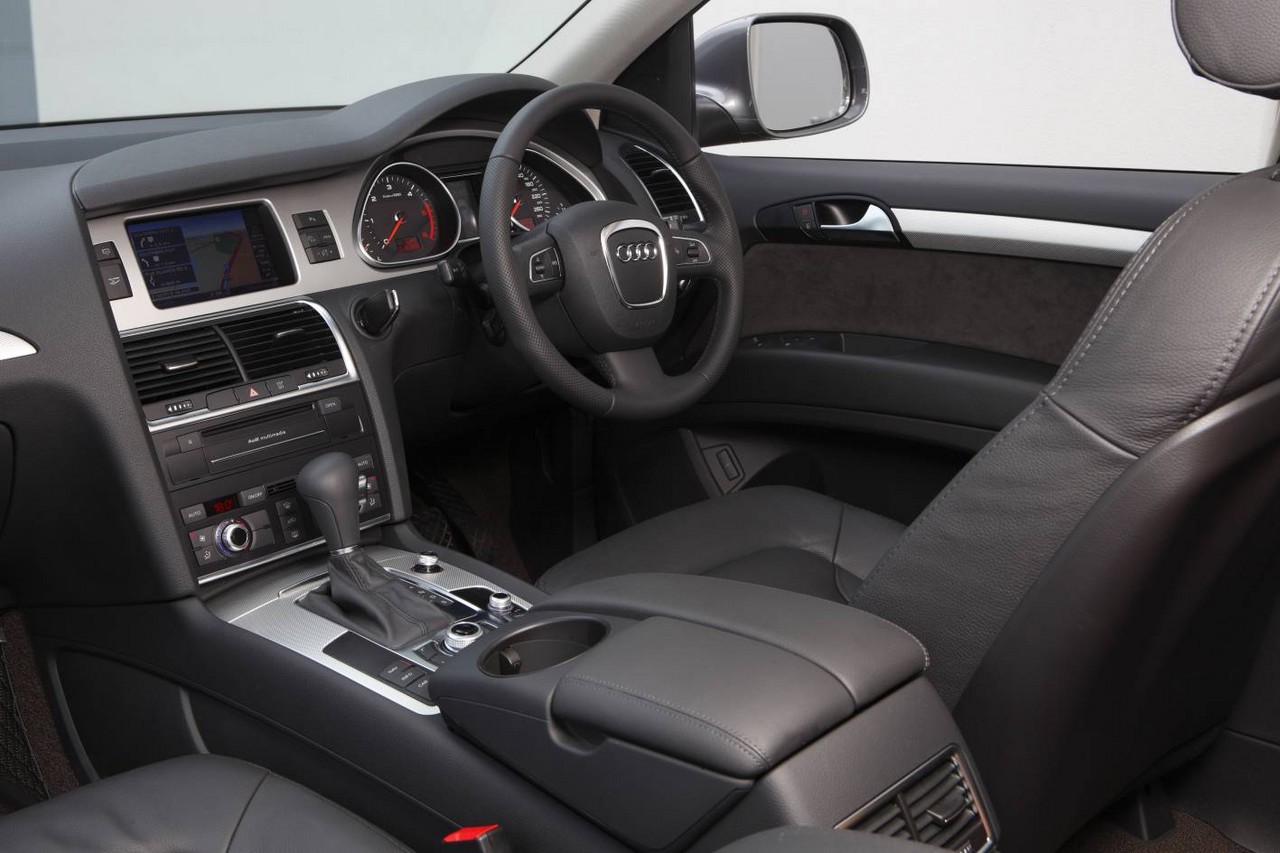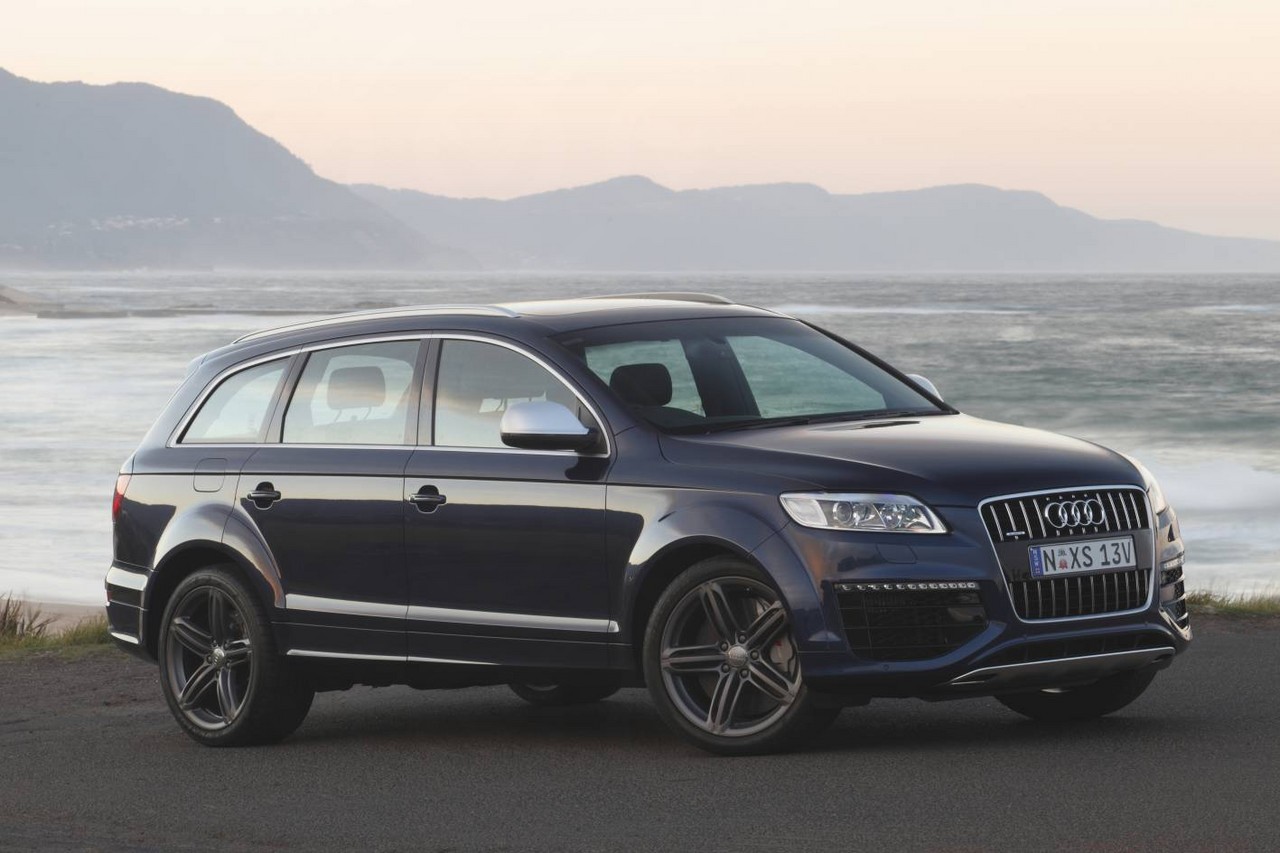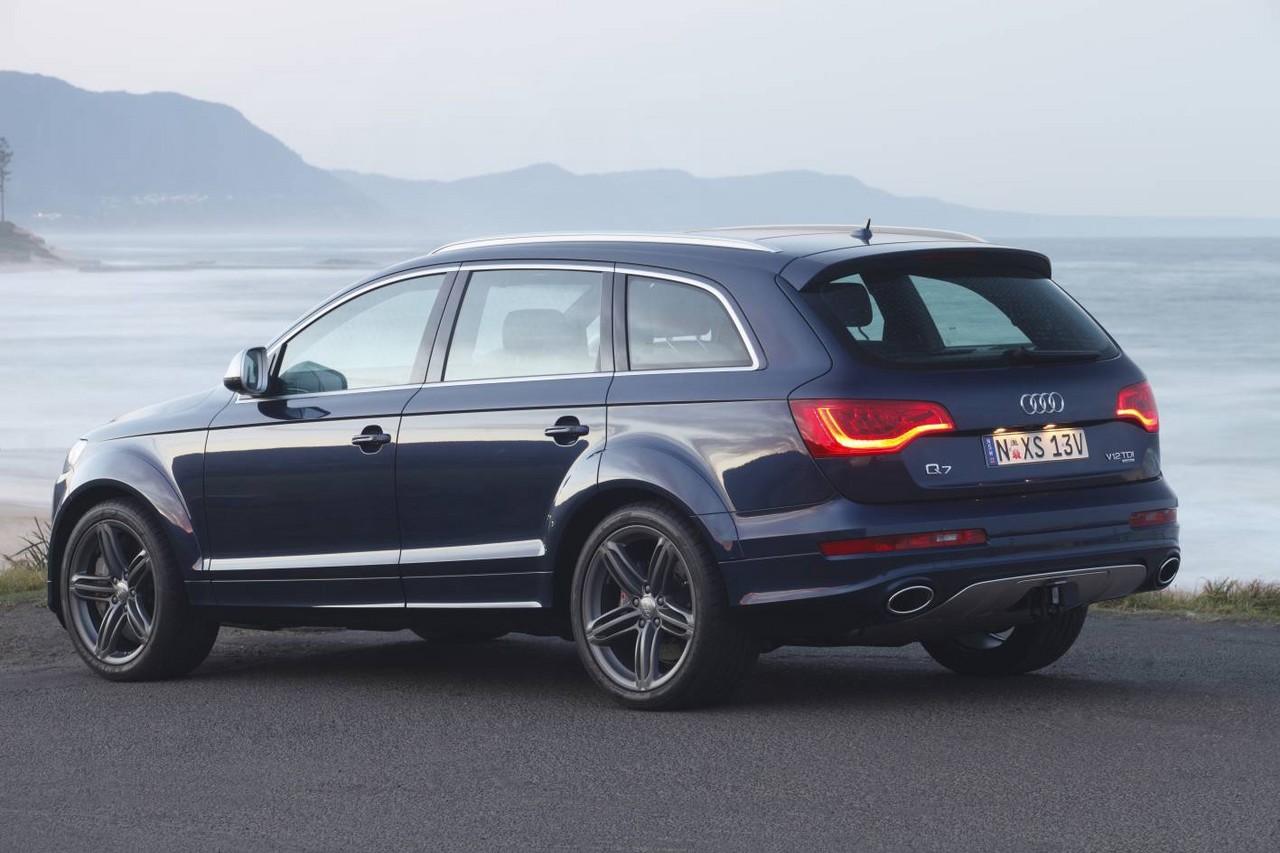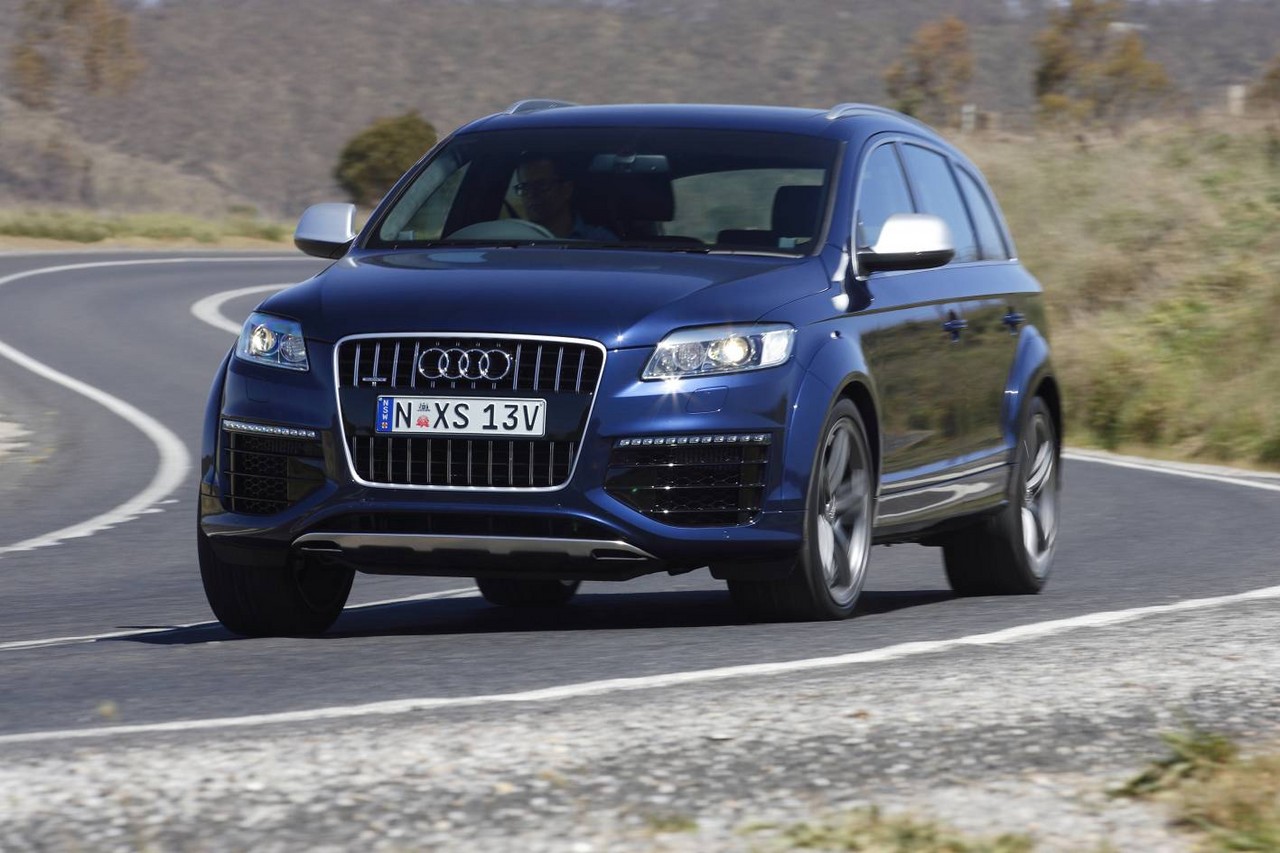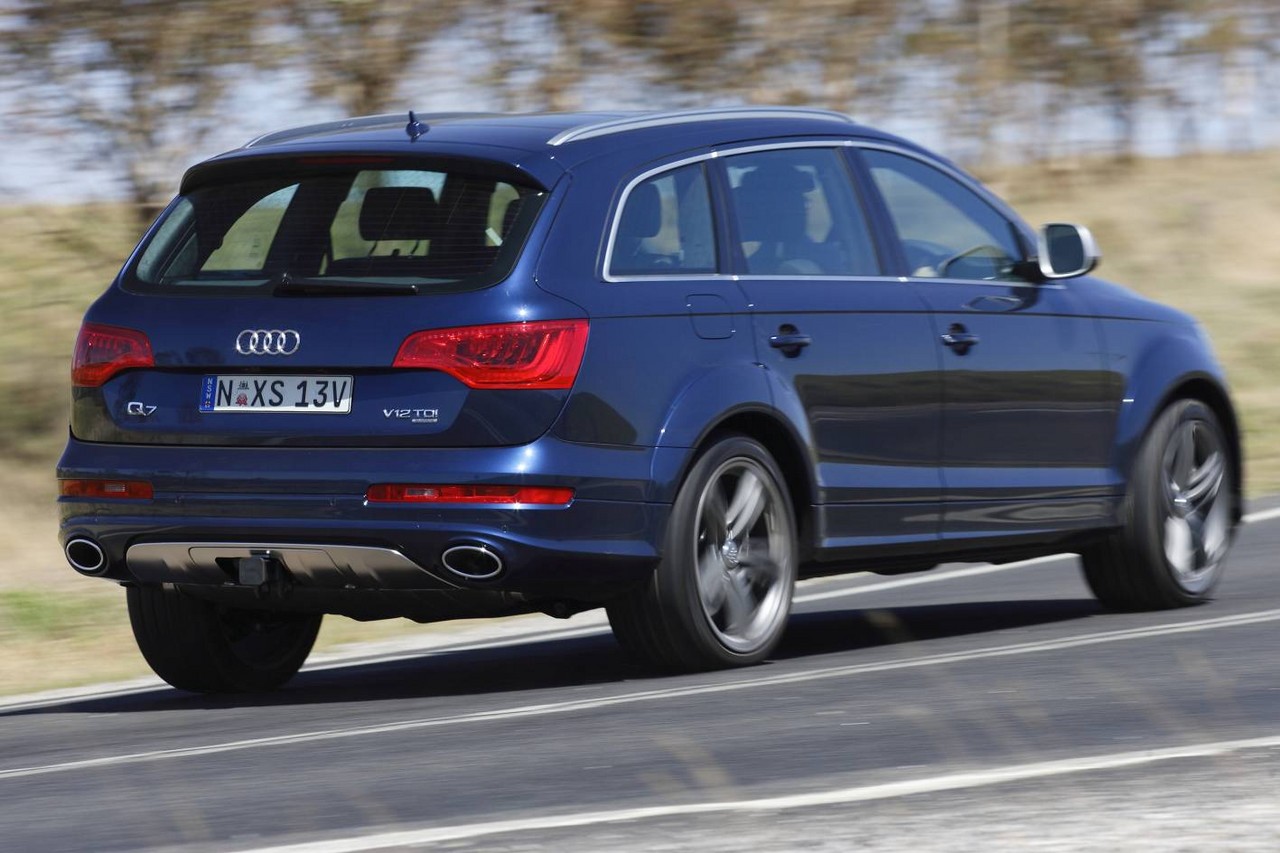
- Responsive turbo-diesel engines
- High quality interior fit and finish
- Impressive dynamics
- Air suspension provides comfortable ride
- Standard coil spring suspension lacks compliance
- Inconsistently weighted steering lacks feel
- 3.6 FSI and 4.2 FSI engines susceptible to carbon deposits on the intake valves
- Weight dulls performance and agility
Review: Audi 4L.I Q7 (2006-09)
Overview
Released in September 2006, the Audi 4L Series I (4L.I) Q7 was a large SUV. Manufactured in Bratislava, Slovakia, the Q7 range initially consisted of the 3.0 TDI and 4.2 FSI variants, with the 3.6 FSI following in November 2006 and the 4.2 TDI in October 2007. Despite its name, the Q7 initially had five seats as standard, with six or seven seat packages optional. From October 2008, however, seven seats were fitted as standard though buyers could opt for five seats (at no additional cost).
| Variant | Engine | Trans. | Years | Peak power | Peak torque |
|---|---|---|---|---|---|
| 3.6 FSI | 3.6-litre BHK petrol V6 | 6sp auto | 2006-09 | 206 kW at 6200 rpm | 360 Nm at 2500-5000 rpm |
| 3.0 TDI | 3.0-litre BUG turbo-diesel V6 | 6sp auto | 2006-08 | 171 kW at 4000 rpm | 500 Nm at 1750-2750 rpm |
| 3.0-litre CASA turbo-diesel V6 | 6sp auto | 2008-09 | 176 kW at 4000-4400 rpm | 550 Nm at 2000-2250 rpm | |
| 4.2 FSI | 4.2-litre BAR petrol V8 | 6sp auto | 2006-09 | 257 kW at 6800 rpm | 440 Nm at 3500 rpm |
| 4.2 TDI | 4.1-litre BTR twin-turbo-diesel V8 | 6sp auto | 2007-09 | 240 kW at 3750 rpm | 760 Nm at 1800-2500 rpm |
Dimensions and suspension
The Audi Q7 was based on Volkswagen’s PL71 platform which also underpinned the Volkswagen 7L Touareg and Porsche Mk.1 Cayenne . The Audi Q7 was 5086 mm long, 2000 mm wide, 1772 mm tall and had a 3002 mm long wheelbase.
The Audi Q7 had independent, double wishbone front and rear suspension, with steel-spring suspension and twin-tube shock absorbers. Furthermore, the Q7 4.2 FSI and 4.2 TDI were equipped with adaptive air suspension and an electronically-controlled damping system, with ‘Dynamic’, ‘Automatic’ and ‘Comfort’ modes. With adaptive air suspension, ground clearance could be varied from 180 mm to 205 mm in ‘off-road’ mode and to 240 mm in ‘lift mode’. The boot lip could also be lowered by 71 mm to load cargo.
quattro
The Audi Q7’s quattro four-wheel drive system utilised a Torsen Type 3 centre differential and provided a default front:rear torque split of 40:60. In the event that traction was lost, however, up to 65 per cent of torque could be directed to the front axle, and up to 85 per cent to the rear. The system also included front and rear differential locks which could brake spinning wheels to effectively transfer torque to the opposing wheel (i.e. cross-axle torque transfer).
Safety equipment
Standard safety equipment for the Audi Q7 included dual front airbags, front and second row side airbags, full-length curtain airbags (i.e. for all rows of seats), ABS, electronic brake force distribution, brake assist, electronic stability control, rollover stability control, traction control, hill descent assist, front seatbelt pretensioners and seatbelt load limiters for the front and outer second row seats.
Euro NCAP crash testing
In Euro NCAP crash testing , a 2006 Audi Q7 received a four star safety rating with a score of 29.92 out of 37. During the offset crash test, there was separation of the seam connecting the firewall to the footwell and failure of spot-welds in the footwell and its connection to the A-pillar. Audi subsequently improved quality control over this part of production, though structures in the dashboard also presented a potential risk to the knees and femurs of the driver. In the side impact and pole tests, however, maximum points were awarded.
Features: Audi Q7 3.6 FSI and 3.0 TDI
Standard features for the Audi Q7 3.6 FSI and 3.0 TDI included 18-inch alloy wheels, Multi Media Interface (Audi’s ‘MMI’ ) with a seven-inch colour monitor, eleven speaker stereo, six-stack CD player and reversing camera with parking guidance, climate control air conditioning, leather seats, cruise control, a multi-function steering wheel, front and rear fog lamps, front and rear parking sensors, automatic headlights, rain-sensing wipers, 60/40 split and folding second row seats, flat folding third row seats (where fitted), a leather-wrapped steering wheel, remote central locking, power windows and heated mirrors, tilt and telescopic steering wheel adjustment, full-size spare wheel, luggage cover and net, four 12 volt outlets, aluminium roof rails, a cargo cover, tinted windows, a trip computer and an immobiliser. For six and seven seat models, the second row of seats had fore and aft slide adjustment.
Features: Audi Q7 4.2 FSI
The Audi Q7 4.2 FSI was further equipped with satellite navigation, power adjustable front seats, directional bi-xenon headlights, Bluetooth connectivity, steering wheel gearshift paddles, a power adjustable steering column, power folding mirrors and powered tailgate. Beyond this, the 4.2 TDI was fitted with 20-inch alloy wheels, four zone climate control air conditioning and driver memory settings (seat and steering wheel).
Q7 3.6 FSI SE
From 2007, the Audi Q7 3.6 FSI was offered in an ‘SE’ edition. Compared to the standard 3.6 FSI, the SE omitted leather seats, power adjustable front seats, automatic headlights and rain-sensing wipers.
Review: Audi 4L.II Q7 (2009-15)
Overview
Released in November 2009, the Audi 4L Series II (4L.II) Q7 introduced an expanded range with the 6.0 TDI, powered by a 6.0-litre twin-turbo diesel V12 engine. Visually, the Audi 4L.II Q7 could be identified by its revised single-frame grille (high-gloss black finish with chromed vertical bars), new front bumpers with contrasting lower sections and two-tone rear bumpers new front. Models with xenon headlights were also fitted with daytime LED running lights. Inside, Audi’s third-generation MMI was introduced, while there was also a new instrument cluster, ambient door lighting and revised seats and trim.
In September 2010, the Audi Q7 range was updated: the 3.6 FSI and 4.2 FSI were discontinued, effectively replaced by the 3.0 TFSI. Furthermore, the 3.0 TDI engine had an ‘idle stop’ (engine shut-down when stationary), the 4.2 TDI engine was upgraded and an eight-speed automatic transmission was introduced for all variants other than the 6.0 TDI.
| Variant | Engine | Trans. | Years | Peak power | Peak torque |
|---|---|---|---|---|---|
| 3.6 FSI | 3.6-litre BHK petrol V6 | 6sp auto | 2009-10 | 206 kW at 6200 rpm | 360 Nm at 2500 rpm |
| 3.0 TDI | 3.0-litre CASA turbo-diesel V6 | 6sp auto | 2009-10 | 176 kW at 4000 rpm | 550 Nm at 2000-2250 rpm |
| 3.0-litre CJGA urbo-diesel V6 | 8sp auto | 2010-15 | 176 kW at 3800-4400 rpm | 550 Nm at 1750-2500 rpm | |
| 4.2 FSI | 4.2-litre BAR petrol V8 | 6sp auto | 2009-10 | 257 kW at 6800 rpm | 440 Nm at 3500 rpm |
| 3.0 TFSI | 3.0-litre CJT supercharged petrol V6 | 8sp auto | 2010-15 | 245 kW at 5500-5400 rpm | 440 Nm at 2900-5300 rpm |
| 4.2 TDI | 4.1-litre CCFA twin-turbo-diesel V8 | 6sp auto | 2009-10 | 250 kW at 4000 rpm | 760 Nm at 1800-2500 rpm |
| 4.1-litre CCFB twin-turbo-diesel V8 | 6sp auto | 2010-15 | 250 kW at 4000 rpm | 800 Nm at 1750-2750 rpm | |
| 6.0 TDI | 5.9-litre twin-CCGA turbo-diesel V12 | 6sp auto | 2009-15 | 368 kW at 3750 rpm | 1000 Nm at 1750-3250 rpm |
Features
Compared to their 4L.I predecessors, the Audi 4L.II Q7 3.6 FSI and 3.0 TDI variants were fitted with a single-disc CD player (previously a six-disc changer), while he 4.2 FSI and 4.2 TDI received four-zone climate control air conditioning and a TV tuner.
Compared to the 4.2 FSI and 4.2 TDI, the 6.0 TDI was further equipped with 21-inch wheels, a fourteen speaker Bang & Olufsen stereo, adaptive cruise control and a power sunroof.
Related links
- Specifications: Audi 4L.II Q7 (September 2011)
- Specifications: Audi 4L.II Q7 (December 2013)
- Wikipedia.org: Audi Q7
